- 1. Wix – User-Friendly and Flexible
- 2. Squarespace – Polished Designs for Creatives
- 3. WordPress – Ultimate Flexibility and Scalability
- 4. Webflow – Design Freedom for Tech-Savvy Freelancers
- 5. GoDaddy Website Builder – Quick and Integrated Solution
- 6. Shopify – E-Commerce Powerhouse for Selling Products
- 7. Weebly – Simple and Budget-Friendly
- Choosing the Right Builder for Your Needs
- Conclusion
Freelancers must have more than talent to stand out in a crowded market. A professional website can be used to display their portfolio, skills, and services to potential clients. Website builders have made it easier than ever for independent professionals to build a site. In fact, nearly three-quarters of respondents (74%) who have built a website used an easy-to-use website builder like Wix or Squarespace instead of programming the website from scratch. Today, website builders have become so popular that there are over 18 million websites on the Internet that are built with DIY website builders. This article covers the best website builders for freelancers and compares seven of the top tools. 2025 updated stats, examples and insights for the top website builders for the freelancer.
You can use a modern site builder with glitch-free drag-and-drop controllers, templates, and even AI design assistants to reduce the time it takes to create your website. This means that even non-tech savvy people can quickly set up a personal web site. Below, we take a closer look at seven of the best platforms for freelance professionals, considering their features, pricing, and best use cases. Each tool has its strengths, and thus freelancers should select according to the needs they have – whether it is showcasing creative work, selling products, or simply having an online resume. Let’s get into this article from 1Byte and see what makes each one shine out.
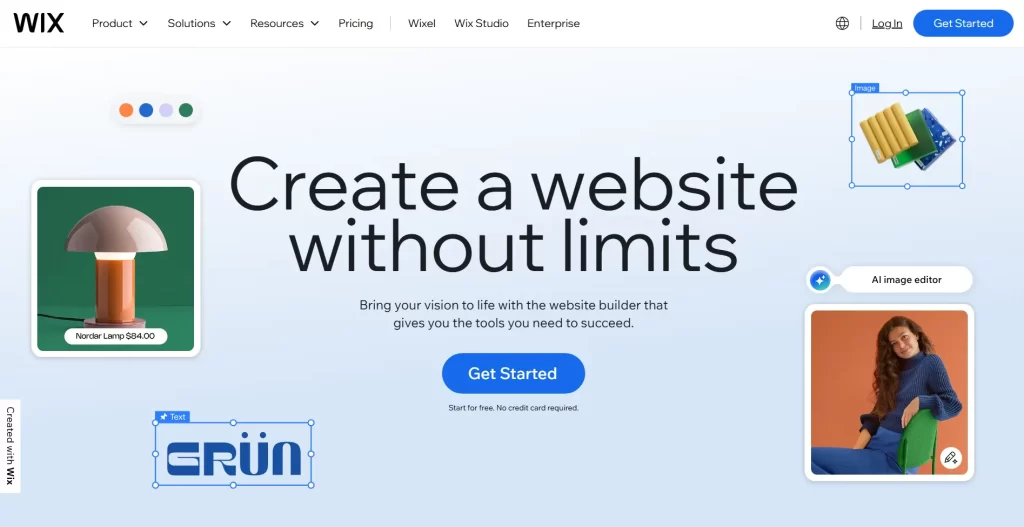
1. Wix – User-Friendly and Flexible
Wix is one of the most popular website builders in the world, with a user-friendly interface and extensive design options. It has a simple drag-and-drop interface which allows the freelancers to build a website without writing any code. Wix has hundreds of templates (over 900) for all types of professions and styles, ranging from the freelance graphic designers to the consultants. Users can customize layouts, add galleries, add contact forms, booking apps, etc. from the Wix App Market. This flexibility means that a freelancer can customise their site to their brand and needs.
- Huge User Base: Wix has a proven track record, with over 260 million users worldwide as of mid-2024. It holds about 45% of the global market share among DIY website builders, making it the market leader. This large community means plenty of support, tutorials, and third-party integrations are available.
- Ease of Use: The platform is very intuitive. A freelancer can choose a template, then easily replace text and images with their own content. The Wix ADI (Artificial Design Intelligence) can even generate a starter website after asking a few questions, which speeds up setup for those in a hurry.
- Built-in Tools: Wix comes with integrated SEO guidance (via the Wix SEO Wiz), analytics, and marketing tools to help freelancers get found by clients. It also supports e-commerce, so a freelance artist or craft maker can sell products online if needed.
For instance, a freelance photographer can use Wix to develop a gorgeous portfolio site in a day. They can begin with a photography template, import their best shots, and use Wix’s gallery and slideshow features to display their work. Wix’s free plan is available for experimenting and once prepared, a paid plan (from about $17 per month) will enable freelancers to connect a custom domain and eliminate Wix ads. Remember, although there is a free version of Wix, serious professionals will want a premium plan to look more professional. Overall, Wix’s combination of simplicity and power is a winning combination. It is only natural that Wix is used by roughly 3.8% of all websites as of 2025 – a testament to its popularity among both individuals and businesses alike.

2. Squarespace – Polished Designs for Creatives
Squarespace is known for its elegant, modern designs and is especially popular with creatives and design-based independents. It provides one-stop solution wherein hosting, designing, and even purchasing the domain name are combined. For freelancers, such as photographers, designers, writers or consultants who are looking for a sleek and professional solution out-of-the-box, Squarespace is a good candidate.
- Stunning Templates: Squarespace offers award-winning templates that are very polished. Even without any tweaking, these designs instantly lend any freelance portfolio or service site a credibility factor. The layouts focus more on visuals and typography, which is excellent for presenting portfolios or case studies. A freelance illustrator, for example, can use a Squarespace template to show off his artwork in an online gallery that looks like it was custom-designed.
- Built-In Features: This platform comes with several built-in tools that can be useful for small businesses and freelancers, such as blogging and e-commerce features. It has native blogging, and this allows a freelance copy writer or content creator to maintain a blog to draw traffic. It also comes with a built-in online store module, thus the freelancer selling products or digital downloads can do it on the same site. SEO and analytics tools are included, which helps users optimize their site visibility without requiring external plugins.
- Popularity and Usage: Squarespace is the second most popular website builder in the world by market share (with approximately 18% of the DIY builder market). It’s especially popular in the United States where it’s actually the most popular website builder platform in use. There are nearly 3 million live websites running on Squarespace as of late 2024 and Squarespace has more than 4.6 million paid subscriptions. The platform is well-proven and continuously updated due to its popularity.
Squarespace tends to attract freelancers who value aesthetics. For example, many creative agencies and wedding photographers develop their websites on Squarespace for its stylish photo galleries and style options. The editing interface is very user-friendly, but a little more structured than Wix – you select sections and blocks to edit, as opposed to absolute drag-and-drop. One thought to consider is that Squarespace can be a bit less flexible in terms of customization, you may not be able to move elements around as much which keeps designs consistent, but it can be limiting if you plan to make advanced tweaks. Squarespace’s prices start at approximately $16 per month (personal plan) if paid yearly. Although it is not the most affordable option, it is a high-end touch. Overall, Squarespace is great for freelancers that want a professional, sophisticated website without any design work – Squarespace has a great template that makes your content look good right from the get-go.
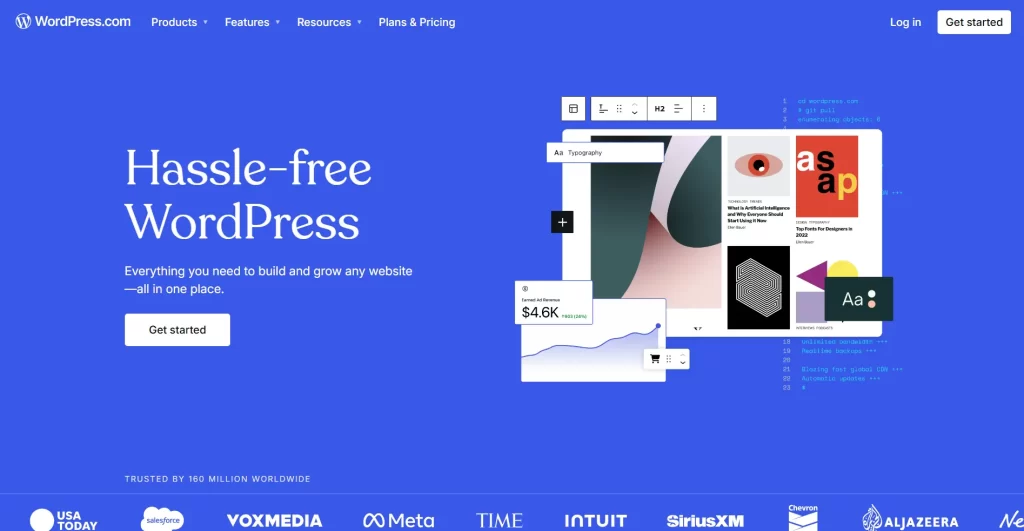
3. WordPress – Ultimate Flexibility and Scalability
WordPress is used for an enormous percentage of the web and it’s a favourite for many freelancers who are looking for complete control over their site. There are two flavours of WordPress: WordPress.com (a hosted service which is more like a site builder) and WordPress.org (self-hosted open-source software). Either way, WordPress is unrivaled in its flexibility provided by its plugin and theme ecosystem. It is a little more complicated than simply drag and drop builders, but it can be extremely rewarding for those who are willing to learn the ropes.
- Dominant Market Share: WordPress is used by around 43% of all websites on the internet – an astonishing figure that includes many freelance sites, small business pages, and major corporate blogs alike. In terms of content management systems (CMS), WordPress holds about 62% of that market. This means a freelancer choosing WordPress is building on the same platform trusted by millions of others, ensuring longevity and support.
- Plugins and Themes: One of the largest advantages of WordPress is the large amount of themes and plugins. Freelancers can find themes made especially for portfolios, resumes or businesses websites. For instance, a freelance writer may add a clean blogging theme to publish the articles and a portfolio plugin to display samples of writing. There are more than 60,000 free plugins available (and many premium ones) that can add virtually any functionality – from SEO optimization to booking calendars. Tools such as Elementor, a drag and drop page builder plugin, make it much easier to design pages, and can give a WordPress site builder like simplicity.
- Ownership and Control: With WordPress (especially the self-hosted version), the freelancers have full ownership of their site and content. You can tailor everything about the site’s appearance and behavior and you’re not bound to one service provider. This can be important in terms of scalability – as a freelancer’s business grows, their WordPress site can grow with it. They can add a store front using woocommerce, membership system, galleries, forms or whatever.
For example, think of a freelance blogger or a coach who needs to publish content on a regular basis and maybe even sell digital products. WordPress would enable them to have a blog, a sales page selling e-books or courses, an email list sign up form, and so on – all in one site. It does come with a learning curve however. Setting up hosting, install wordpress, for self hosted, extra workload for updates/security. However, managed WordPress hosting or the WordPress.com’s plans can do a lot of that for a fee. Many freelancers get started with WordPress.com as an easy way to get started, but migrate to self-hosted WordPress.org as they need to do more. The effort can be worth it: WordPress tends to be limitless in terms of what you can build. Just bear in mind that it might take a little more time to learn than it does to Wix or Squarespace, and there is some maintenance (backups, updates) to do. For those who take the time to learn how to use it, WordPress can be truly adaptable to any need – meaning it’s a powerhouse choice for those freelancers seeking to have complete control of their web presence.
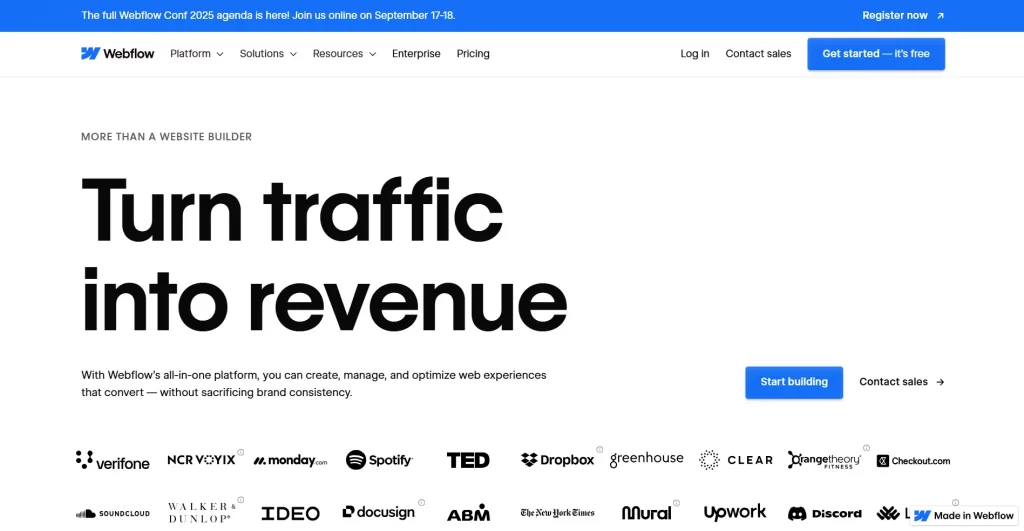
4. Webflow – Design Freedom for Tech-Savvy Freelancers
Webflow: a more advanced website builder for designers, developers and freelancers that want to have pixel-perfect control without writing any code. It’s a no-code platform, but it really feels like a professional design tool – where users can play with CSS styles, animations and layouts. For freelancers with a web design background or a strong desire for something unique, Webflow will provide the freedom to design something truly custom.
- Professional Design Tools: Webflow’s experience is similar to a combination of a design software and CMS. You have the ability to get started from scratch or a template and change all aspects of the layout. It allows you to create responsive design (so that you can design separately for desktop, tablet and mobile views), and advanced effects like parallax scrolling, animations and interactive elements. Unlike other simpler builders, Webflow does not limit you to preset templates – you can arrange pages in any way you like. That means that a freelance web designer can use Webflow to prototype and build up the client’s site with finely tuned branding and unique layouts – all without having to write code.
- CMS and Blogging: Webflow comes with a CMS for dynamic content management. Freelancers who wish to operate a blog or to frequently update projects, can create “Collections” (such as a portfolio collection, a blog posts collection) and style its items’ appearance. It’s kind of like building your own WordPress, but all within Webflow visual builder. This feature is of interest to those that might find other builders too restrictive in the way content is organized.
- Growth and Adoption: While Webflow is newer on the scene, it has been growing steadily. As of 2025, Webflow powers about 0.8% of all websites – roughly 493,000 sites – and holds ~1.2% share among CMS-driven websites. This may sound small, but it’s an impressive footprint for a specialized tool, and it reflects a dedicated user base of designers and freelancers. Webflow’s community provides many templates and how-to guides, and the company has been improving features rapidly.
A good example use-case would be a freelance UX/UI designer, who wants to make their portfolio site stand out from the crowd with a totally bespoke design. With Webflow, they were able to create a custom grid, interactive case study pages, and subtle animations that would be challenging to create in Wix or Squarespace. However, this power comes at a cost – Webflow can have a steeper learning curve and can be overwhelming for beginners. It is often referred to as “not as difficult as coding, but more difficult than standard website builders.” Webflow can create very high-quality results, for a freelancer who is willing to learn it. Pricing starts with a free tier for basic development that is taken up to about $14 per month (billed annually) for a basic site plan to connect a custom domain (higher on CMS/business plans). In summary, Webflow is ideal for those who prioritize complete design control and are willing to dedicate the time to learn it – essentially, it offers the power of coding with a visual interface, resulting in a truly unique online presence.
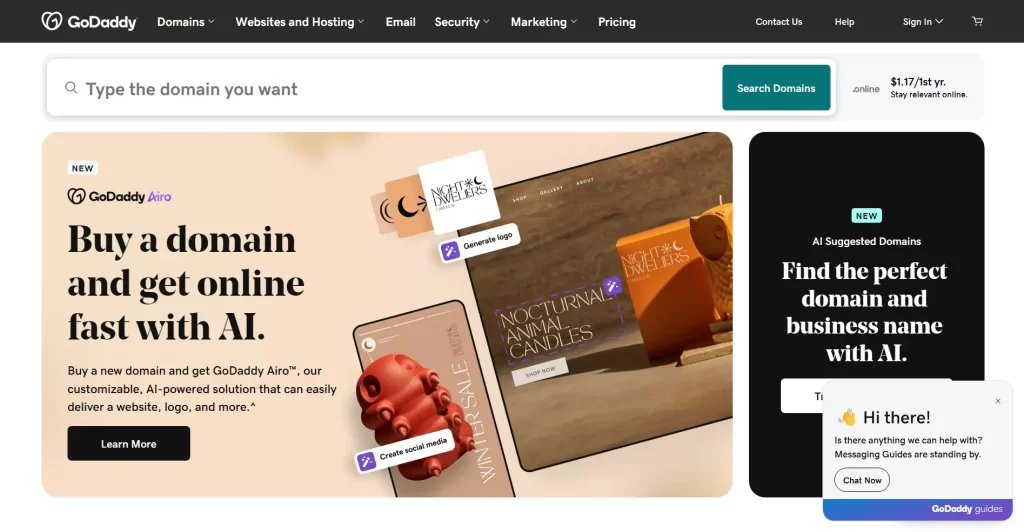
5. GoDaddy Website Builder – Quick and Integrated Solution
GoDaddy’s Website Builder (commonly known as “Websites + Marketing”) is a website builder offered by the renowned domain registrar and web hosting company GoDaddy. It is designed with the intention to be straightforward and quick to use so that anybody who is a freelancer or small business owner can create a simple website without much hassle. Many freelancers will already be using GoDaddy for domain names or email, so using their site builder can be a nice all-in-one solution.
- Simplicity and Speed: The GoDaddy builder is based on a step-by-step guided approach. Users select a category and site name and it creates an initial design which you can then edit easily using a simple editor. It’s very beginner-friendly – a no-web experience freelancer can follow the prompts and have a basic site live in an afternoon. This makes it appealing for, for example, an independent consultant or handyman who just wants a straightforward online business card containing contact details and a brief description of services offered.
- Integrated Marketing Tools: As the name suggests, Websites + Marketing has some marketing and business tools integrated into it. It has inbuilt tools for SEO advice, email marketing, even integrating with social media and booking an appointment. For instance, a personal trainer, who works as a freelancer, could use GoDaddy to build a site and also provide class scheduling or send email newsletters to clients, all from a single dashboard. While these features aren’t the most advanced, they cover the basics for someone who wants to manage everything in one place.
- Market Position: GoDaddy’s builder has the global market share of the top three website builders. It is the third most popular simple site builder in the world by market percentage, and surprisingly, in the U.S., it is the second most popular simple site builder (after Squarespace). This popularity is due to the huge customer base of GoDaddy in domains and hosting. It is convenient to build the site by the same company. As of 2024, the parent company of GoDaddy has billions of dollars in revenue from its web presence segment which includes the builder, which means a lot of users. The basic plan is also among more affordable plans – around $10-$11 per month for a basic plan – so it’s not too expensive.
One other thing to mention is that GoDaddy templates and design flexibility are a little bit limited. The designs are clean and functional but not as visually impressive as Squarespace, for example. There are enough templates, and the customization options are limited just to make it simple. It’s a trade off in terms of convenience – you may not have a flashy site but you will have a working one in no time. This is for the freelancers who find speed and convenience more important than optimizing the design. Also, if you have purchased a domain from GoDaddy, it is easy to connect it to a GoDaddy created site. So in summary, GoDaddy’s Website Builder is best for simple websites on a tight timeline. It’s like the fast food of site builders, quick, easy, gets the job done; it may not win a gourmet prize for design, but it’s still food.
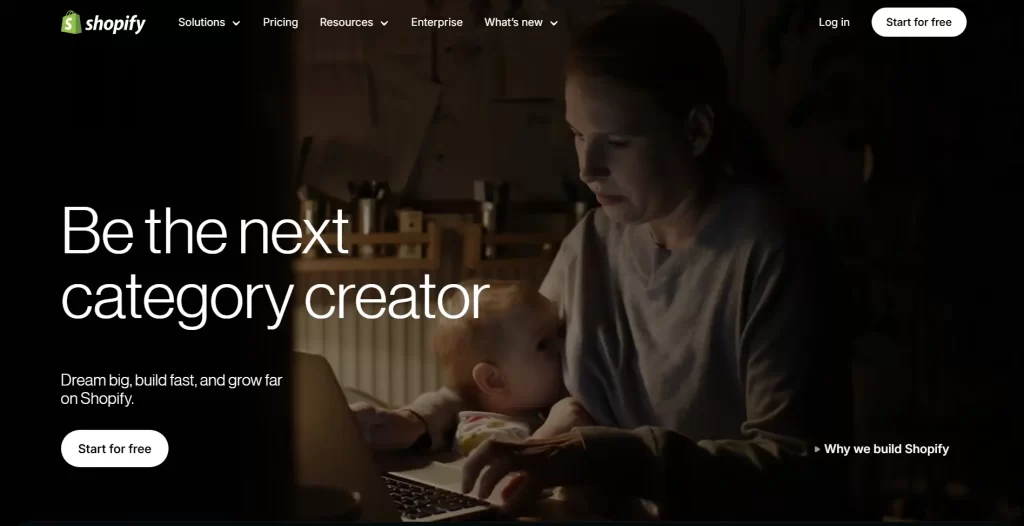
6. Shopify – E-Commerce Powerhouse for Selling Products
Shopify is a dedicated E-Commerce website builder. It’s the go-to option for anyone who plans to sell products or services online, and can be a great option for freelancers who have a store as part of their business. For example, a freelance artist of prints, a craft maker that sells handmade goods, or even a consultant that sells digital products (like e-books or templates) might consider Shopify. While Shopify is famous for online stores, it is also possible to create an informational page or even blog in it, so a freelancer can create an entire website with a store section built in with this platform.
- Best-in-Class E-Commerce Features: Shopify’s best-in-class e-commerce features make all of the features that would be a pain to implement on other builders. It does the product listing, inventory management, shopping cart and checkout, payment processing, and product order management easily. It supports several payment gateways and has their own Shopify Payments system for a hassle-free experience. Additionally, Shopify has a large app store where you can add additional functionality (like dropshipping tools, advanced analytics, customer chat, etc.) to your store. A freelance entrepreneur can go ahead and start selling without worrying about the technicalities of security or building a cart system – Shopify has that built in and is highly optimized.
- Strong Market Presence: Shopify is one of the largest players in the website builder space by revenue and user count. Over 2 million merchants use Shopify to run their online stores. By early 2024, there were approximately 4.6 million live Shopify stores on the web. It’s also the leading e-commerce website platform globally, with about 26% of the e-commerce market share (more than any other single e-commerce solution). This platform processed over $197 billion in gross merchandise volume in 2022 alone, showing how much business flows through it.
- Easy to Use, Focused on Selling: Although it is a powerful platform, Shopify is built to be friendly to use. Setting up a simple store is as simple as adding products, setting prices, choosing a theme, and you are ready to start selling. The themes are targeted to product presentation and sales conversion. For example, a freelance jewelry maker might choose a clean theme, which would display pictures of their products and integrate certain features such as customer reviews and related products. Shopify does all of the hard work with SSL security, mobile responsive designs, and even includes a free small scale email marketing tool.
It’s worth noting that if a freelancer doesn’t intend to actually sell anything, they’ll almost always find that Shopify is more than they need (and it’s one of the pricier options, starting at $29/month for basic plans). This platform is at its best where you have a catalog of products or services to sell. Also, Shopify is very scalable – if the freelancer’s side business becomes a massive online shop Shopify can scale with them (with higher tier plans and more advanced apps). One potential drawback is that content management (for lots of non-product pages or a complex blog) is not yet a Shopify focus, so pure content creators may find its interface a little constricting compared to WordPress or Squarespace. However, Shopify has realised this and provides blogging features and even information sections, it just isn’t as robust as some others for content heavy sites. In sum, for the entrepreneur who is a freelancer who sells goods or services online, Shopify is difficult to beat. It’s a tool that does commerce superbly well, which can save time and help drive sales professionally from the first day.
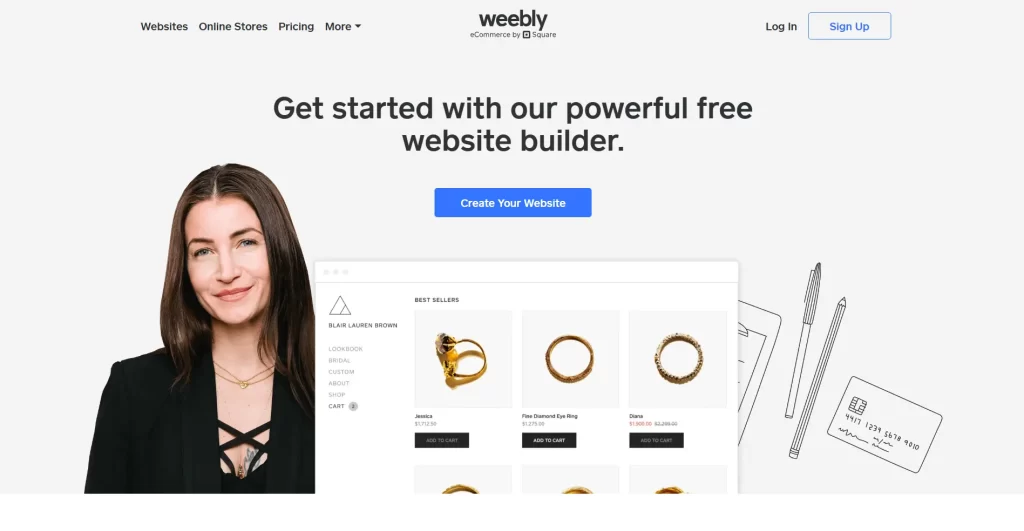
7. Weebly – Simple and Budget-Friendly
Weebly is a website builder that has been around for quite some time since the mid-2000s. Purchased by Square (the payments company), Weebly has merged with eCommerce functionality and is still considered one of the easiest builders to use. Weebly is a good choice for budget-conscious freelancers or for those looking for a no-frills website solution. While Weebly has slowed its development in recent years and some users have moved to flashier platforms, the website still powers millions of websites and provides an equilibrium between simplicity and functionality.
- Easy Drag-and-Drop Editor: Weebly’s editor is really easy to use. Freelancers can select from a wide range of themes and then drag elements (text boxes, images, galleries, contact forms, etc.) on their pages. It’s very much what you see is what you get, so it’s a good choice for people who don’t want to be bothered with any technicality. A freelance consultant or virtual assistant, for example, may be able to rapidly create a professional-looking site listing services and testimonials just by using the pre-designed sections of Weebly and replacing the text.
- Integrated with Square for E-commerce: Weebly has been acquired by Square, which has enhanced its e-commerce and payment capabilities. Weebly may also be used by a freelancer who may occasionally sell a few goods or accept client payments online (using Square’s payment gateway). It is not as powerful as Shopify for large catalogues, but for selling a few items or accepting orders for services, it is good enough. From inventory management to an easy checkout and even providing digital goods, Weebly offers options for all this. For instance, a freelance designer could promote design templates or an e-book right from their Weebly site with very little fuss of configuration.
- User Base and Market Share: Weebly has reported that it has over 50 million sites built on its platform. While not all of these are active today, it shows the reach Weebly had. As of recent analyses, the number of actively used Weebly sites is lower (BuiltWith estimates around 800,000 live Weebly sites in 2025), partly because some users transitioned to other platforms or were integrated into Square’s ecosystem. However, Weebly still ranks among the widely used site builders globally. It remains one of the most widely used platforms, often cited with over 40 million users worldwide. Its popularity has been higher in the past, but it continues to serve many small websites.
One of the selling features of Weebly is cost. It offers a free plan (although your site will be branded by Weebly) and paid plans that are generally more affordable than some of the competition. Lower tier paid plans are in the neighborhood of $10-$12 per month and provide a custom domain and eliminate ads, so it’s very inexpensive for those freelancers that care about budget. The drawback is that Weebly’s template designs and features are not as advanced or comprehensive as Wix or Squarespace. Weebly’s templates are satisfactory, but they can be perceived as a bit unoriginal or outdated without editing. Paradox features (e.g. some marketing tools or design flexibility) have limitations. Weebly, however, has all the basics for a simple portfolio or informational site. It is reliable and easy to follow. For example, an independent translator can set up a Weebly site with a homepage, an “About Me” section, a portfolio or a showcase of work or client logos and a contact form. This could be accomplished in a day or two and the result would be an effective, clean website that conveys professionalism. Weebly: Weebly won’t be the hottest builder on the market, but it is still relevant – especially for freelancers who want to be on the Web quickly without too many choices.
Choosing the Right Builder for Your Needs
All seven of these tools can help freelancers create a quality website, but the best website builder for freelancers will depend on individual needs and priorities. It’s clear that website builders have become the preferred method for most people building a site – coding from scratch has taken a backseat as these platforms have matured. Even in surveys, a large share of users turn to web builders because they are faster and easier for non-developers. Each of the builders we compared has its niche:
- Wix is a great all-around choice, extremely user-friendly with a huge template selection and app ecosystem. It suits most freelancers who want a balance of ease and flexibility.
- Squarespace shines for those who value design polish and a professional look, ideal for visual creatives or anyone who wants their site to look like it was made by a pro designer.
- WordPress offers ultimate flexibility and scalability – perfect for freelancers who need specific features or plan to grow their site significantly (and who don’t mind a bit of a learning curve).
- Webflow is tailored for design perfectionists and tech-savvy users who want complete control over layout and aesthetics – essentially creating a custom website without coding.
- GoDaddy Website Builder appeals to freelancers who need a simple, quick web presence and like the idea of having domains, hosting, and site editing in one place with minimal setup.
- Shopify is unmatched for e-commerce, so it’s the top pick if selling products or services online is a central part of a freelancer’s business.
- Weebly provides an easy and budget-friendly way to make a site, suitable for basic portfolios or service pages, especially for those who want something straightforward and low-cost.
When deciding, freelancers should consider what features matter most: Is it a gorgeous design? Ease of use? Specific functions like a booking calendar or store? Also, consider long-term needs – a platform like WordPress or Shopify can grow with you if you envision expanding your site’s capabilities in the future. On the other hand, if you just need a simple online profile, a lightweight builder like Weebly or GoDaddy might suffice.
New trends are also emerging. Many of these builders have started integrating artificial intelligence to assist with design and content. For example, Wix’s ADI and Squarespace’s AI LayoutEngine can help generate layouts or suggest improvements automatically. This means that the process of creating a professional-looking site is becoming even more accessible. In 2024 and beyond, we can expect site builders to continue simplifying the experience – perhaps to the point where a freelancer can almost just describe their ideal site and have it created by AI.
Leverage 1Byte’s strong cloud computing expertise to boost your business in a big way
1Byte provides complete domain registration services that include dedicated support staff, educated customer care, reasonable costs, as well as a domain price search tool.
Elevate your online security with 1Byte's SSL Service. Unparalleled protection, seamless integration, and peace of mind for your digital journey.
No matter the cloud server package you pick, you can rely on 1Byte for dependability, privacy, security, and a stress-free experience that is essential for successful businesses.
Choosing us as your shared hosting provider allows you to get excellent value for your money while enjoying the same level of quality and functionality as more expensive options.
Through highly flexible programs, 1Byte's cutting-edge cloud hosting gives great solutions to small and medium-sized businesses faster, more securely, and at reduced costs.
Stay ahead of the competition with 1Byte's innovative WordPress hosting services. Our feature-rich plans and unmatched reliability ensure your website stands out and delivers an unforgettable user experience.
As an official AWS Partner, one of our primary responsibilities is to assist businesses in modernizing their operations and make the most of their journeys to the cloud with AWS.
Conclusion
In conclusion, a good website is a valuable tool for a freelancer. It is a 24/7 business card, portfolio and sales pitch to potential clients globally. However, it is now more straightforward than ever to build one without hiring a developer or learning how to program. By selecting one of these best website builders, freelancers can set up a credible and remarkable online presence in scarcely any time.
Out of all the top 7 tools we compared, each of them has helped thousands of people go from having no website to a fully functional site that gets them new opportunities. With the statistics showing the prevalence and power of these platforms – Wix alone powers almost half of all DIY builders, and WordPress powers a large percentage of the web – it’s obvious that using a website builder is a smart, efficient way to make your way into the online marketplace. Freelancers shouldn’t be nervous to choose the platform that suits their style and objectives knowing that all of these platforms have the potential to deliver a professional result. By putting together the above points and data, you will be able to make a well-informed decision for creating your freelancer website and present your best to the digital world.

